Integrin signaling in cancer: bidirectional mechanisms and therapeutic opportunities
- PMID: 37770930
- PMCID: PMC10537162
- DOI: 10.1186/s12964-023-01264-4
Integrin signaling in cancer: bidirectional mechanisms and therapeutic opportunities
Abstract
Integrins are transmembrane receptors that possess distinct ligand-binding specificities in the extracellular domain and signaling properties in the cytoplasmic domain. While most integrins have a short cytoplasmic tail, integrin β4 has a long cytoplasmic tail that can indirectly interact with the actin cytoskeleton. Additionally, 'inside-out' signals can induce integrins to adopt a high-affinity extended conformation for their appropriate ligands. These properties enable integrins to transmit bidirectional cellular signals, making it a critical regulator of various biological processes.Integrin expression and function are tightly linked to various aspects of tumor progression, including initiation, angiogenesis, cell motility, invasion, and metastasis. Certain integrins have been shown to drive tumorigenesis or amplify oncogenic signals by interacting with corresponding receptors, while others have marginal or even suppressive effects. Additionally, different α/β subtypes of integrins can exhibit opposite effects. Integrin-mediated signaling pathways including Ras- and Rho-GTPase, TGFβ, Hippo, Wnt, Notch, and sonic hedgehog (Shh) are involved in various stages of tumorigenesis. Therefore, understanding the complex regulatory mechanisms and molecular specificities of integrins are crucial to delaying cancer progression and suppressing tumorigenesis. Furthermore, the development of integrin-based therapeutics for cancer are of great importance.This review provides an overview of integrin-dependent bidirectional signaling mechanisms in cancer that can either support or oppose tumorigenesis by interacting with various signaling pathways. Finally, we focus on the future opportunities for emergent therapeutics based on integrin agonists. Video Abstract.
Keywords: Bidirectional signaling mechanisms; Integrin; Integrin-targeting drugs; Tumorigenesis.
© 2023. BioMed Central Ltd., part of Springer Nature.
Conflict of interest statement
The authors declare no competing interests.
Figures



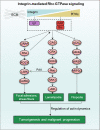
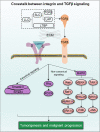
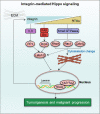
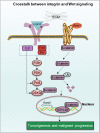
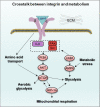
Similar articles
-
Chemokine arrest signals to leukocyte integrins trigger bi-directional-occupancy of individual heterodimers by extracellular and cytoplasmic ligands.Cell Adh Migr. 2010 Apr-Jun;4(2):211-4. doi: 10.4161/cam.4.2.11133. Epub 2010 Apr 5. Cell Adh Migr. 2010. PMID: 20372052 Free PMC article. Review.
-
Integrins in cell adhesion and signaling.Hum Cell. 1996 Sep;9(3):181-6. Hum Cell. 1996. PMID: 9183647 Review.
-
Atypical structure and function of integrin αV β8.J Cell Physiol. 2021 Jul;236(7):4874-4887. doi: 10.1002/jcp.30242. Epub 2020 Dec 27. J Cell Physiol. 2021. PMID: 33368230 Review.
-
Negative regulators of integrin activity.J Cell Sci. 2012 Jul 15;125(Pt 14):3271-80. doi: 10.1242/jcs.093641. Epub 2012 Jul 20. J Cell Sci. 2012. PMID: 22822081
-
Why integrin as a primary target for imaging and therapy.Theranostics. 2011;1:30-47. doi: 10.7150/thno/v01p0030. Theranostics. 2011. PMID: 21544229 Free PMC article.
Cited by
-
Integrative transcriptome analysis identifies a crotonylation gene signature for predicting prognosis and drug sensitivity in hepatocellular carcinoma.J Cell Mol Med. 2024 Oct;28(20):e70083. doi: 10.1111/jcmm.70083. J Cell Mol Med. 2024. PMID: 39428564 Free PMC article.
-
Therapeutic Resistance Models and Treatment Sequencing in Advanced Prostate Cancer.Cancers (Basel). 2023 Nov 3;15(21):5273. doi: 10.3390/cancers15215273. Cancers (Basel). 2023. PMID: 37958444 Free PMC article.
-
ITGA5 promotes cervical cancer progression by regulating IMP3 recruitment of HK2 mRNA.Am J Transl Res. 2025 Apr 15;17(4):3031-3049. doi: 10.62347/GGVE9638. eCollection 2025. Am J Transl Res. 2025. PMID: 40385029 Free PMC article.
-
Fibroblast Activation Protein (FAP)+ cancer-associated fibroblasts induce macrophage M2-like polarization via the Fibronectin 1-Integrin α5β1 axis in breast cancer.Oncogene. 2025 Jul;44(28):2396-2412. doi: 10.1038/s41388-025-03359-3. Epub 2025 Apr 22. Oncogene. 2025. PMID: 40263422
-
Encapsulation and assessment of therapeutic cargo in engineered exosomes: a systematic review.J Nanobiotechnology. 2024 Jan 3;22(1):18. doi: 10.1186/s12951-023-02259-6. J Nanobiotechnology. 2024. PMID: 38172932 Free PMC article.
References
Publication types
MeSH terms
Substances
LinkOut - more resources
Full Text Sources
Medical

